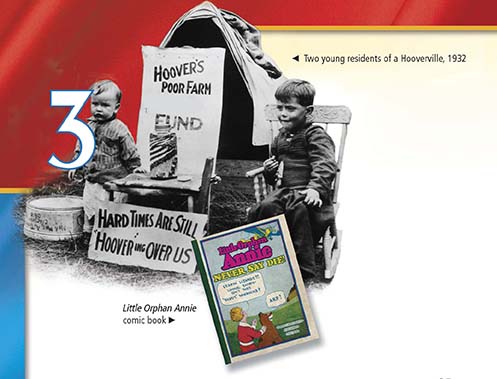SECTION 3: Hoover’s Response Fails

WITNESS HISTORY  AUDIO
AUDIO
Rugged Individualism
Despite their suffering during the 1930s, children remained important symbols of hope and resilience. Harold Gray’s Little Orphan Annie, one of the most popular comic strips of the time, entertained millions of children with stories of a strong-willed orphan and her sidekick dog Sandy. Gray depicted Annie’s many adventures and described her determination in the face of various challenges.
Although much of his young audience did not realize it, the conservative Gray was preaching a philosophy of “rugged individualism” through Little Orphan Annie. He summed up his heroine’s message of self-reliance when he noted that “Annie is [tough], with a heart of gold and a fast left, [and] can take care of herself because she has to.”
Objectives
- Discuss how Hoover’s initial conservative response to the depression failed.
- Explain the changes in the President’s policies as the crisis continued.
- Describe how Americans reacted to Hoover’s relief programs.
Terms and People
- localism
- RFC
- trickle-down economics
- Hoover Dam
- Bonus Army
- Douglas MacArthur
NoteTaking
Reading Skill: Identify Supporting Details As you read, fill in the outline with details about President Hoover’s response to the depression.
- Cautious Response to Depression Fails
- Hoover Turns to Volunteerism
- Calls on business leaders to maintain employment, wages, prices
- Volunteerism Fails to Bring Relief
- Hoover Adopts More Activist Policies
Why It Matters From big cities to small towns, the Great Depression spread misery far and wide across America. The unemployed and the homeless crowded into shantytowns. Giant dust storms swallowed the Great Plains. Yet as the crisis deepened, Herbert Hoover struggled to respond to the nation’s problems. As a result of Hoover’s failed response, in 1932 Americans would turn to a new leader and increased government intervention to stop the depression. Section Focus Question: Why did Herbert Hoover’s policies fail to solve the country’s economic crisis?
Cautious Response to Depression Fails
Herbert Hoover did not cause the Great Depression. But Americans looked to him as their President to solve the crisis. He tried. Hoover was an intelligent man, familiar with business methods and economic theory. He labored long hours, consulted a wide range of experts, and tried to marshal the resources of the country to solve the problems of the depression. As the economic situation worsened, he tried several different approaches. In the end, he failed to discover the right formula, but it was not because of a lack of effort.
Hoover Turns to Volunteerism
At the start of the economic downturn, Hoover followed a hands-off policy. Like most economists of the day, Hoover viewed the upswings and downswings of business cycles as natural occurrences. He felt that government should not




